Read through the blockchain series-Blockchain architecture from a business economic perspective
With the continuous development of blockchain technology and the continuous exploration of application scenarios, blockchain technology has gradually evolved into three basic architectural forms: public chain architecture, alliance chain architecture, and private chain architecture. These three technical architectures each have their own characteristics, and their characteristics are not all the same. The adaptability to business characteristics in different fields and the adaptability of business scenarios vary greatly, of which the public chain and alliance chain are the main practice paths. In addition, the blockchain BaaS platform combined with cloud technology has become the main form of the blockchain to empower the real economy.

Author: 36D brother
Public chain ▶
- Technical Interpretation | Full Analysis of Polkadot Cross-chain Solution
- "2020 Legal Industry Blockchain Development Report" released: What are the potential opportunities for blockchain policies and law firms?
- 14 insurance companies join insurance risk control blockchain platform industry expect application results to accelerate landing
Public chain means that anyone in the world can read and confirm the transaction. Everyone can participate in its consensus blockchain. Any device in the world that can connect to the Internet can read and write blockchain data and confirm operations. Generally, the incentive mechanism is combined with digital verification to verify the transaction, and the data on the blockchain is maintained through the consensus mechanism. The characteristics are: each node has equal power, freely joins or withdraws from the consensus network, has its own endogenous currency, and is highly decentralized.
The public chain is considered to be one of the most promising directions in the field of blockchain. It is more in line with the essence of the blockchain, is the platform most likely to become the next-generation Internet infrastructure, and is the direction with the greatest commercial value.
The commercial prospects of the public chain can be inspired from the history of Internet development. In the first two decades of the birth of the Internet, it has been serving in some specific industry fields and has not entered the masses. What really opened up the popularity of the Internet was the emergence of a phenomenal product-Netscape Browser The device ignited the tide of the Internet boom and opened the entrance of the entire Internet, so that all users who have access to the Internet can easily obtain information. The value lies behind the information. In the Internet 1.0 era, there are almost no desktop applications, and all information is transmitted as web pages based on the http protocol. Therefore, the browser has become the largest entrance to traffic, linking information and people. Netscape browser and later Yahoo search engine opened the Internet.
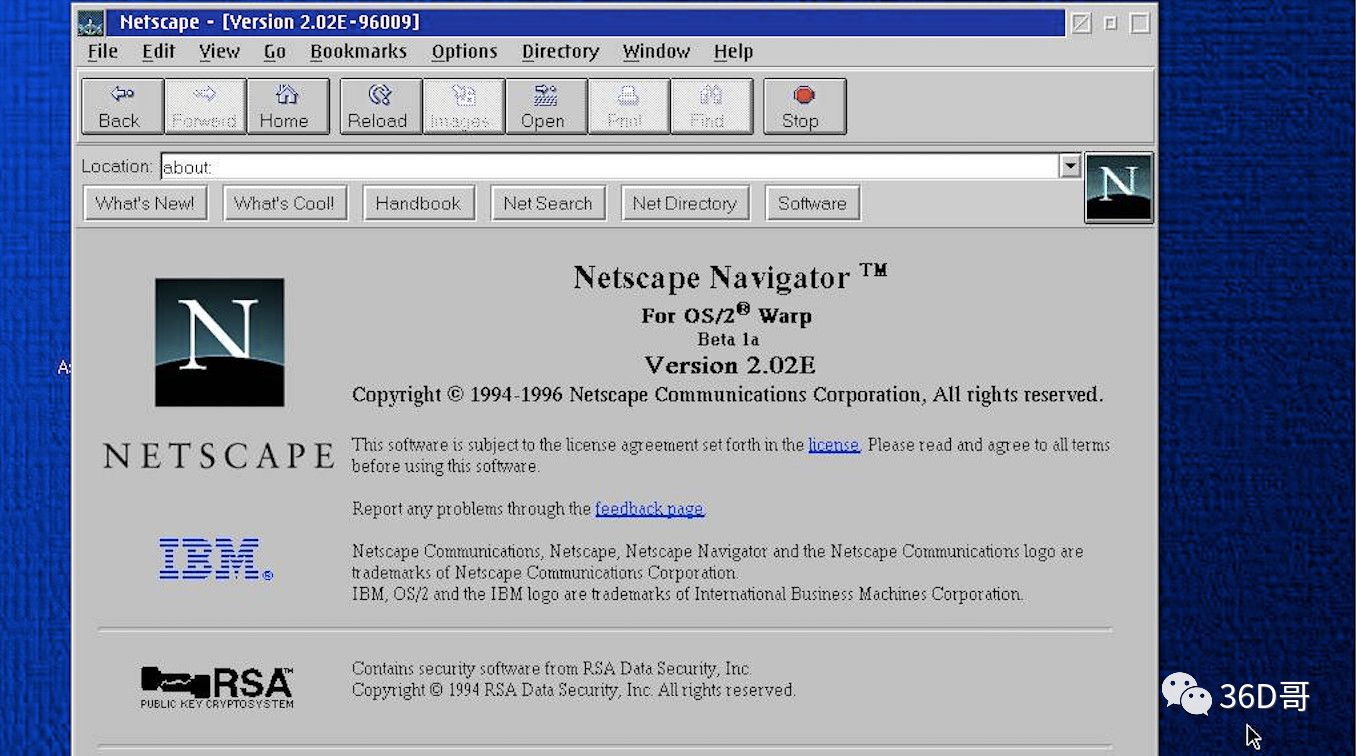
▍Early Netscape browser
Compared with the desktop Internet, the biggest feature of the mobile Internet is that the terminals accessing the network are not fixed, mobile and scattered. Users can access the online to complete the information exchange at any time and any place. In the mobile Internet era, online time is longer, network nodes are more, and interoperability is stronger. It connects not only information and people, but also people. Which product does the best in these two areas has the greatest commercial value. So the most highly valued Internet product in the world is Facebook (connecting 2.7 billion users worldwide), and the most highly valued product in China is WeChat (connecting 900 million users).
In any online network, the lower the access threshold of a node, the more network nodes it will tolerate, the more nodes, the more network connections, and the more diverse and rich the network structure it will ultimately derive. A network connecting 10 nodes and a network connecting 100 nodes, the commercial value of the latter is not 10 times but 100 times of the former. This is the famous Metcalfe's law: the value of a network is equal to the square of the number of nodes in the network, and the value of the network is proportional to the square of the number of users connected to the network. The greater the number of users on a network, the greater the value of the entire network and each computer within that network. The most typical is Taobao.
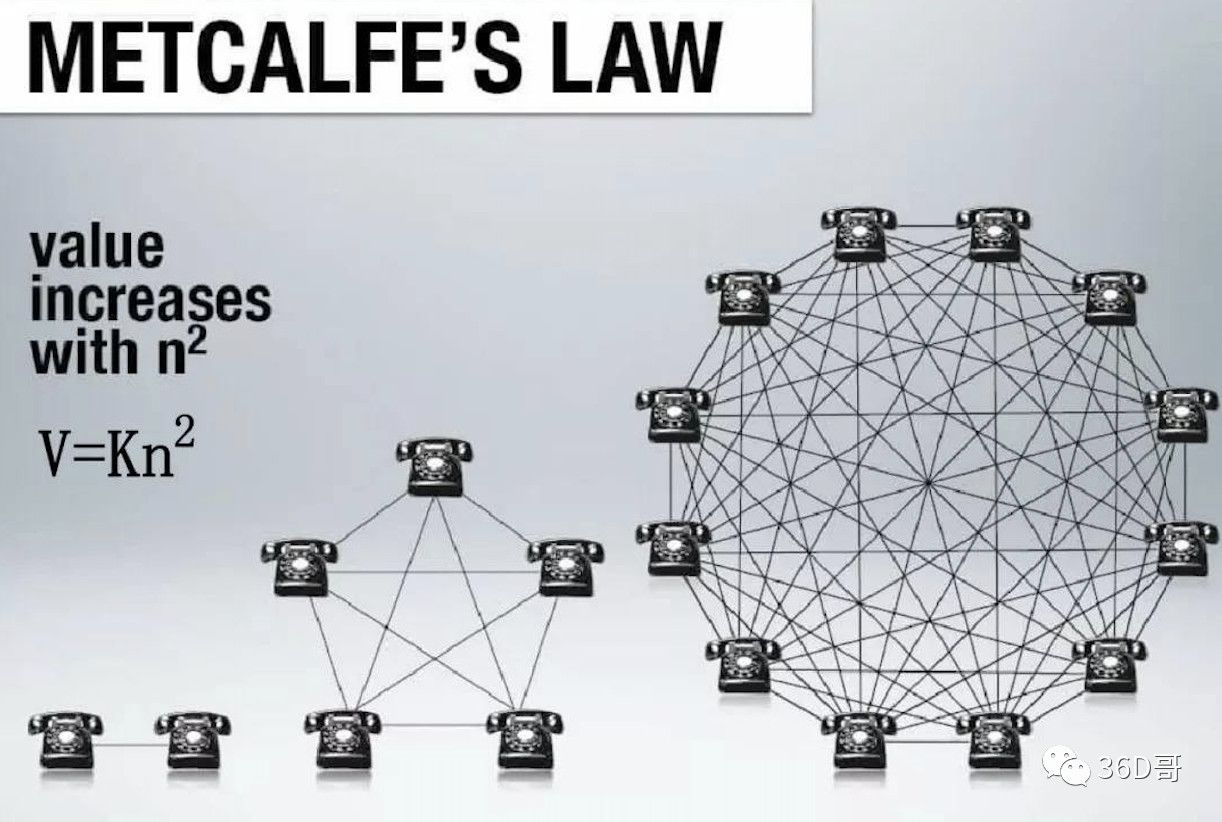
▍Metcalfe's Law
Residents (node roles) on Taobao: consumers, stores, logistics, and countless third-party service providers. From the beginning, the entire network was only a simple connection between single points, and gradually evolved into a Taobao ecology of points into lines, lines into faces, and faces into bodies. The various roles in the ecology are connected and interdependent. Between the role and the platform, the role thrives on the ecosystem, and the platform nurtures the role. All subjects complete the transfer and distribution of benefits in the entire ecology, forming a closed loop of value. The platform is like a petri dish to the role. The platform builds, integrates, collaborates, and standardizes various technical facilities and services. Any resident who wants to leave Taobao ecology will pay a huge cost and need to build their own infrastructure.
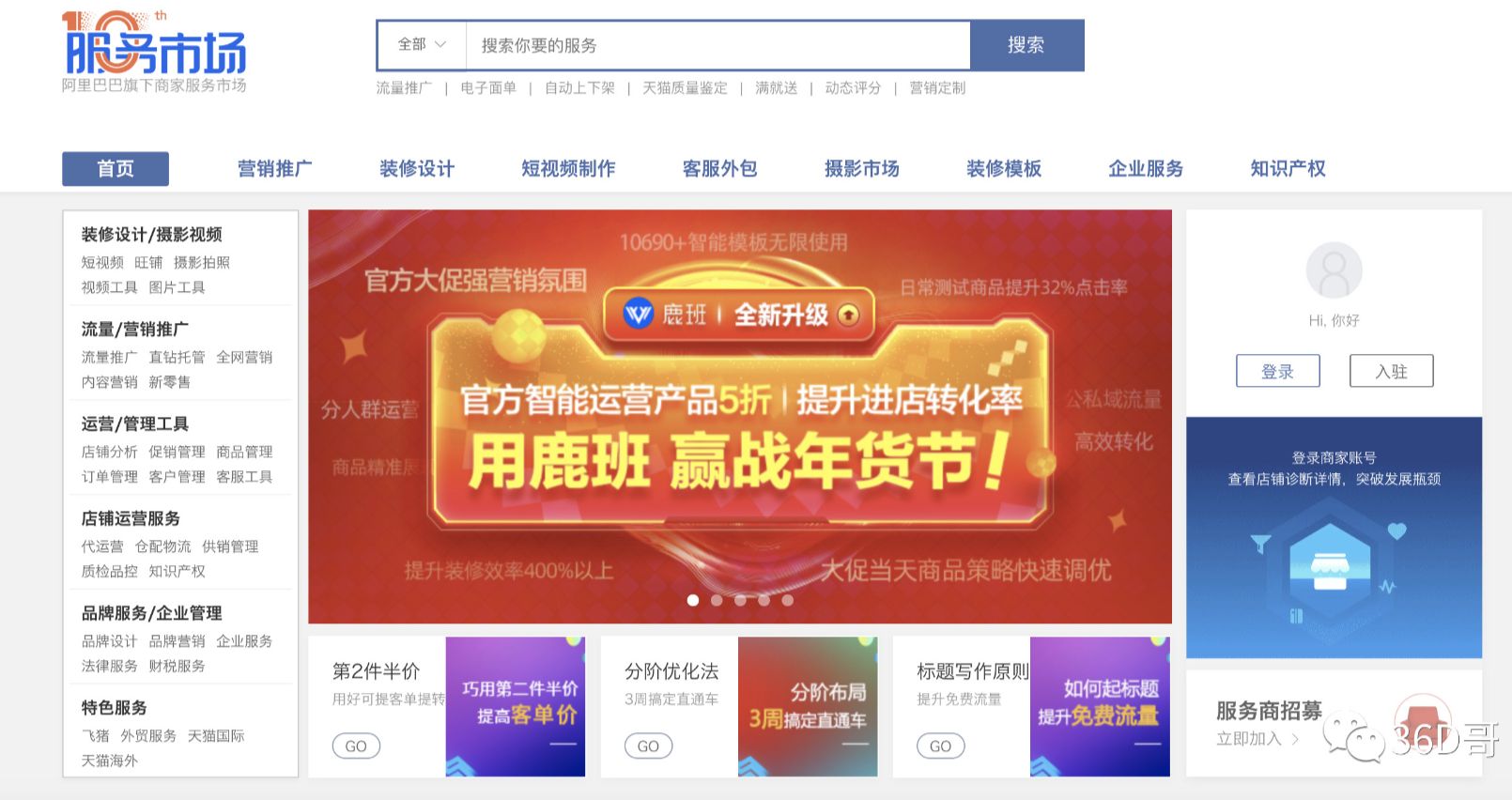
市场 Taobao service market
The public chain has no node access and can be accessed freely throughout the world, which means that this value carrier can reach every user. Individual user needs are diverse and life scenarios are quite different. The needs of life and the purpose of business communication are often very different. The value network that connects these demand points will generate a variety of products and services. In addition, the blockchain itself provides strong trust in a weak trust environment. Intermediate information exchange does not require the intermediary to increase the trust. Compared with the existing Internet network, transaction costs are greatly reduced.
The future of the public chain is undoubtedly the infrastructure that is most likely to become the future value Internet. However, from the perspective of actual practice, there are not many cases of combining public chains and physical business scenarios. It can be said that there are very few, and the phenomenon-level applications that have been vocal for a long time have not occurred. Even everyone has doubts about blockchain technology. Is it a technology bubble? Or is it a technological innovation that can change the future Internet industry?
Blockchain is not a bubble, nor will it happen overnight. For the public chain, large-scale commercialization needs to go through three barriers: one is to improve its own technology, mainly the TPS performance (the number of transactions processed per second); the second is the integration with laws and industry norms, that is, compliance The third is the significant reduction in users' awareness of the concept of blockchain.
The low performance of public chain TPS is related to its own characteristics. Due to its public open nature, there are many network nodes. It takes a long time to reach consensus between nodes and the transaction process is slow. For example, Bitcoin's real throughput is only 7, which means it only supports 7 transactions per second. After Segregated Witness, the efficiency increased by 1.7 times, reaching 12 records per second. Such low throughput is difficult to apply to current business scenarios. In order to improve TPS, major public chain teams have carried out technological innovation, using different consensus algorithms, sharding, multi-layer networks, and main-side architecture … The improvement of processing performance means that more transactions can be matched at the same time, reducing transaction costs.
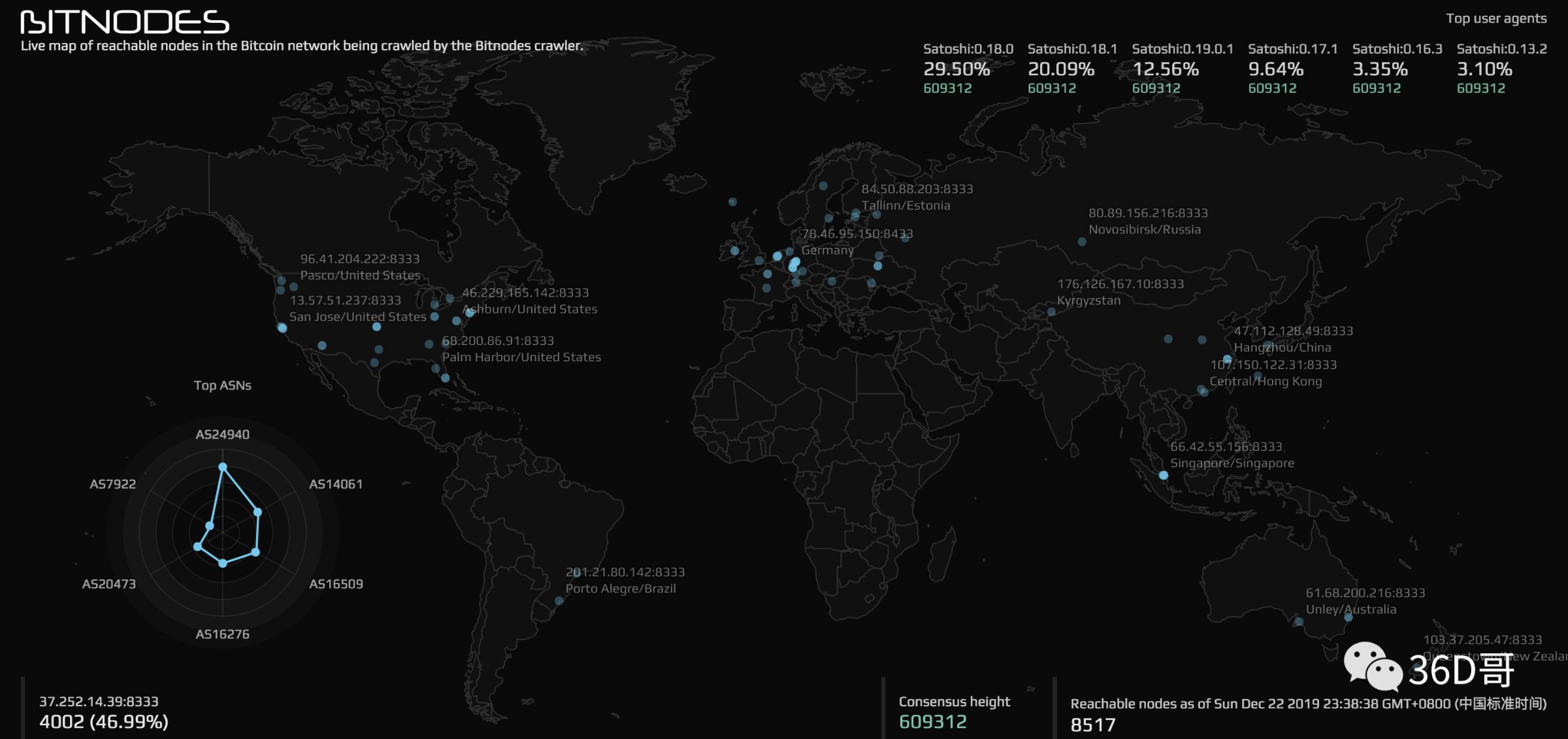
分布 Bitcoin network global real-time number of full nodes (8517) distribution map December 22, 2019 23:38:38
In terms of compliance, it is a major challenge facing the blockchain, especially the public chain. In the final analysis, the blockchain is an aggregate of various technologies that serves the real economy and does not generate any value itself, just like paper money If there is no law giving it as a medium for general transactions and a tool for liquidating debts, it is just a piece of paper.
The characteristics of the public chain network: there is no access mechanism (free to join and exit), no geographical restrictions (worldwide distribution), equal power of each node (complete liberalization), and data cannot be tampered with. When these characteristics are combined with the actual business, there is a very big conflict, which does not meet the legal norms in reality. Here we mainly explain this characteristic of the public chain network from an economic perspective. All kinds of real physical assets and services can be mapped on the blockchain network for quantification, information transmission based on the blockchain trusted network, and various exchanges can be completed. This feature is very similar to Adam Smith's free market. Therefore, the author believes that, similar to the bitcoin network, it is completely free, and the network with equal power of nodes has a limited role in empowering the real economy, and this form of public chain network will not develop too long.
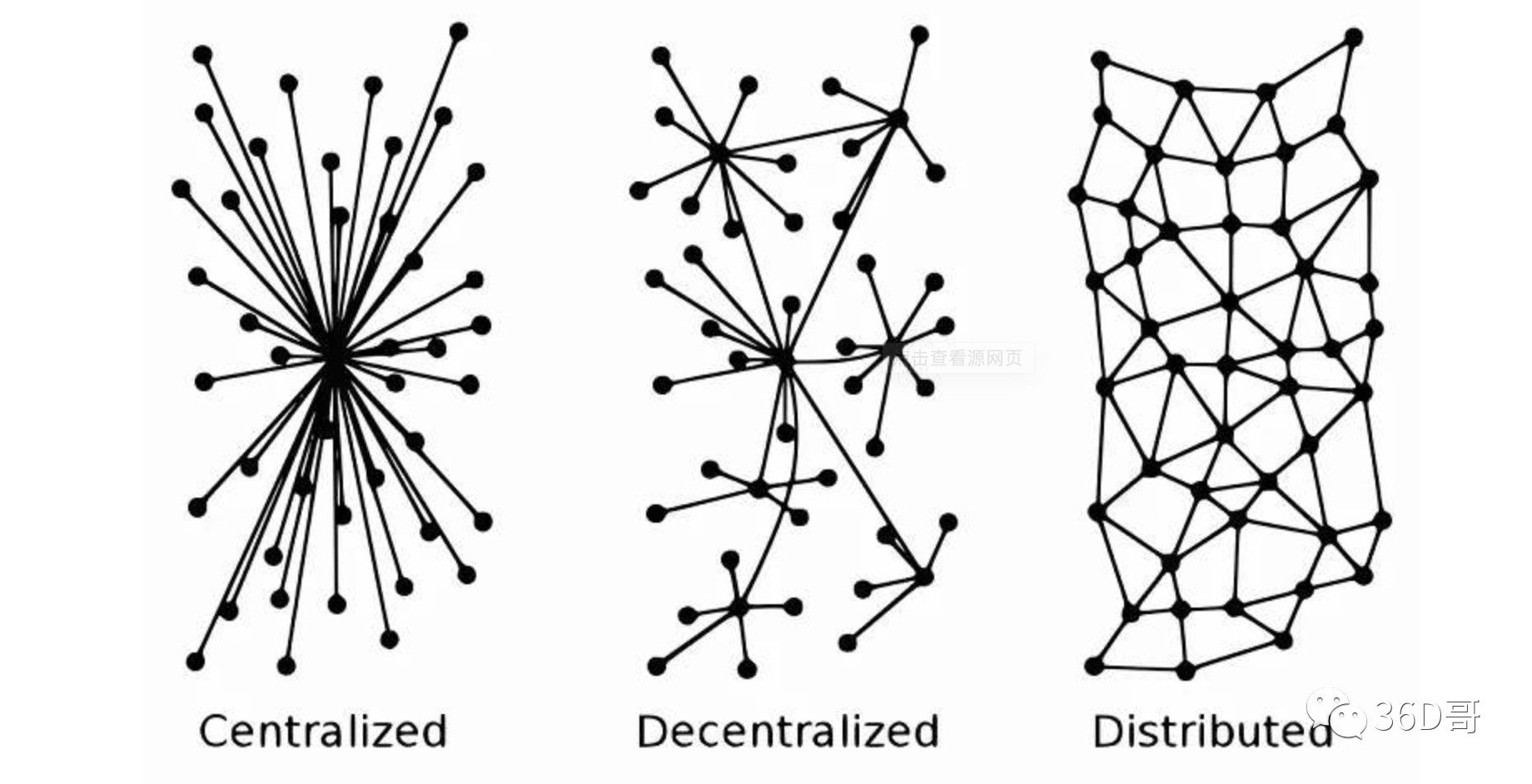
As long as the power of each node on the public chain network is equal, the value of the entire network cannot be maximized. The nodes are completely free and the power is equal, which means that everyone has the same power for scheduling resources, which will cause many problems. The first limited rational individual cannot make the most efficient allocation of resources every time, and even the transactions conducted at some times are harmful to the interests of others. Second, the equivalence of the power of each node will amplify the speculative effect, because other nodes have no control to restrict their own power, and will generate a lot of negative externality transactions. Such negative externality transactions are difficult to govern with technical means. The transaction cost on the third blockchain network is not zero. The distribution of initial power will have an impact on the final value, and it is often difficult for individuals to properly handle the definition of power. Starting from the maximization of utility, supervision must be introduced, and supervision is essentially a power allocation of elements. Because in many cases, the market cannot solve many problems or the cost is very large, such as environmental pollution and defense recruitment, it is necessary to manage these problems through legislative means to maximize the total utility of the entire society.
The immutable characteristics of the blockchain will also cause many practical problems. As anyone can write data on the blockchain, individual nodes on the blockchain may spread all kinds of terrorism-related and pornographic content, such negative energy content. It will always exist on the blockchain network, and content supervision brings great challenges.
Any new thing has a process of being accepted for many reasons, which stem from inertia of thinking, from limited cognition, and from the high cost of migration. But altruism and society will definitely exist. At present, the cost of cognitive blockchain is still very high. The blockchain itself is a comprehensive subject with multiple interdisciplinary subjects, and various technical concepts are difficult for the public to understand. Its private key-based resource management method does not fit the user's mental model. More importantly, the products and services provided by the blockchain technology are far from the experience performance compared with the existing products provided by the traditional Internet technology, and users have no incentive to learn to understand the blockchain. Therefore, the popularity of blockchain is a long process. Without the understanding of large-scale users, large-scale commercial use of blockchain will not be realized.
Alliance Chain ▶
The concept of the alliance chain appeared relatively late. From the perspective of blockchain originalism, the emergence of the alliance chain is a compromise on reality. Because the spirit of the blockchain emphasizes equality, decentralization, and transparency, but the alliance chain has access restrictions, and the power between nodes is not equal. From the perspective of the development of the blockchain, the alliance chain is a major innovation in the technical form of the blockchain. It is the product of continuous adaptation to the adjustment process with the actual business scene. The characteristics of the alliance chain are highly consistent with the actual commercial application scenarios, which lowers the threshold for large-scale commercial use.
The alliance chain refers to a blockchain where several nodes participate in bookkeeping together. Alliance members reach consensus through mutual trust between multiple centers. Only a few nodes specified in advance can have accounting rights, and other joining nodes have transactions only right. The data of the alliance chain only allows members in the system to read, write and send transactions. The biggest difference between the alliance chain and the public chain is that there is an access mechanism and no endogenous incentive design. The admission mechanism is well understood, and joining the alliance chain network needs to meet the pre-agreed qualification conditions. Endogenous incentive mechanism refers to the fact that the alliance chain has no consensus mining, and the node that obtains the right to book is not rewarded with endogenous currency. This one is also the most essential difference from the public chain. The incentives for the nodes participating in the alliance chain are the high efficiency brought by the use of the organizational form of the alliance chain to exchange resources, information, and collaborate with each other to integrate business processes. Reduced the transaction cost of the node body.
This "compromise" design of the alliance chain reflects the integration with reality and the embrace of legal supervision. For example, fewer confirmation nodes, no need for competitive accounting and network-wide confirmation of bills, can greatly increase TPS, so that transaction processing can meet the needs of real business scenarios. The admission mechanism avoids the problem of evil in the public chain. Once an evil node is found, it can find and punish the evil node in time because it has real qualifications for the record. The unequal power can introduce supervisory agencies and audit structures as super nodes to manage evil and problem transactions, which can better solve external problems. The author believes that the architectural form of the alliance chain is more like a mixed economic form (free market economy plus command economy / planned economy).
The characteristics of the alliance chain are naturally suitable for collaboration between multiple organizations and institutions, especially between institutions with different qualifications and resource endowments and highly complementary institutions. Therefore, the financial field is naturally suitable to use the alliance chain to conduct business. The internationally renowned CORDA and the relatively well-known FISCO BCOS in China are alliance chain projects focusing on serving the financial field. We are now talking about the implementation of the blockchain. The blockchain extends to the physical industry, and more refers to the landing scheme of the alliance chain. At present, the alliance chain has landed in many industrial fields such as trade finance, commodity traceability, copyright protection, electronic certificate, industry, energy, Internet of things, e-government, and so on. In these areas, the transformation of physical logistics to information flow is completed, inter-organizational collaboration efficiency is improved, business processes are changed, and a sound industrial environment is built, ultimately improving industrial efficiency and lowering costs.
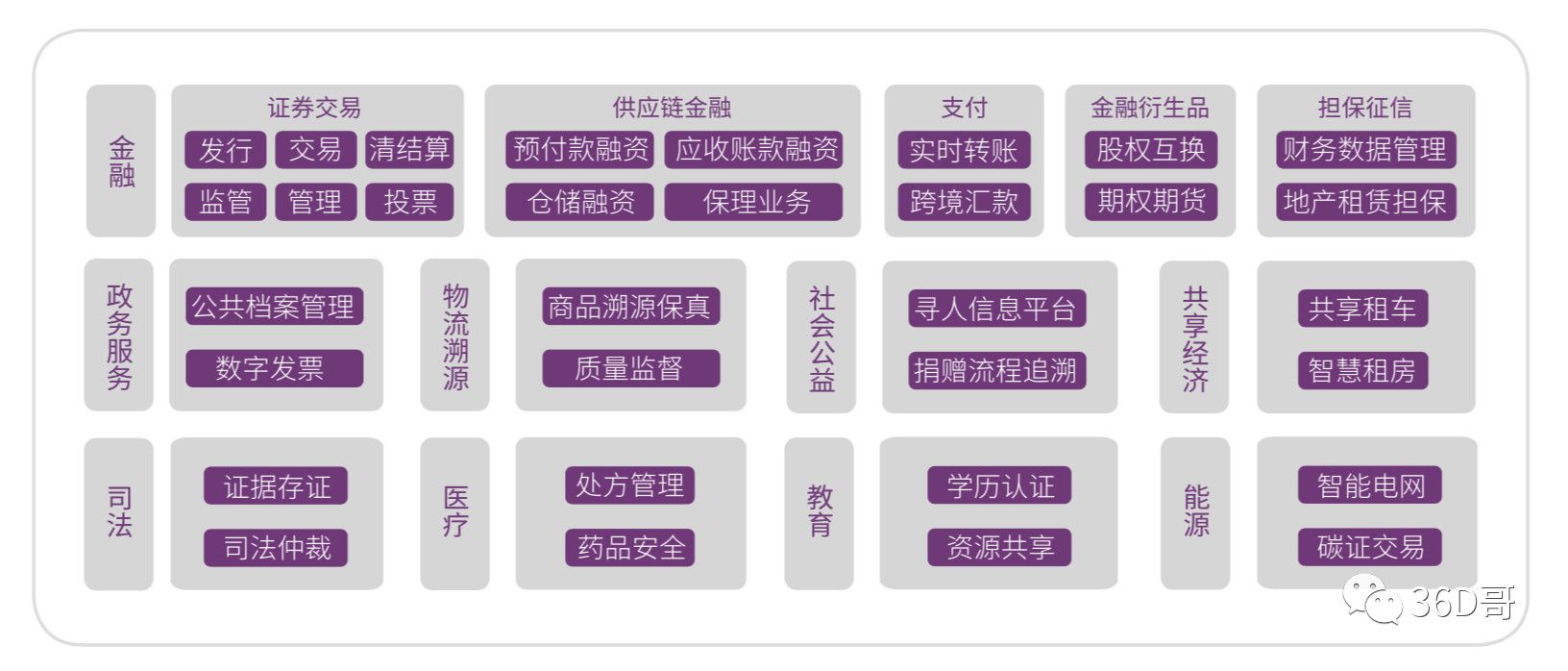
融合 The integration of blockchain technology and the real economy
The growth of the alliance chain has given the blockchain a solid step in empowering the real economy, but overall, the reach is still limited. The participation cost of the nodes in the alliance chain is still relatively high. Most of the participating business entities are enterprises, and they solve some business collaboration problems in the upstream and downstream of their own companies and in their own business ecosystem. Far from getting every consumer within reach and failing to reach the masses. According to Metcalfe's law, the commercial value generated by such a network is limited, and it cannot produce a variety of products and services. In addition, the peculiarity of the alliance chain is difficult to merge with its weakly related business, forming barriers, but reducing circulation efficiency. Even if cross-chain technology is used to carry out a larger range of value transfer between different alliance chains, does this evolve towards a large public chain path?
Uncertainty is a very important variable in economics. Judging from the ten-year evolution of the blockchain, uncertainty is deeply tied to the development of the blockchain. Technology is changing, policies are changing, and the world economy is fluctuating Sexuality has intensified, and governments of different countries have different attitudes towards blockchain. How the future blockchain architecture evolves, we think and see.
Private chain ▶
As the name implies, the private chain has its write permissions in the hands of an organization, and no one else has the right to keep accounts. Data maintenance is done by a subject. Therefore, some people directly deny the private chain as a blockchain, and believe that it cannot be called a blockchain in terms of its characteristics. The characteristics of the private chain and the originalism of the blockchain are very different, more like a database, but their performance is far worse than existing commercial databases, and the value is too low. Therefore, the private chain is more of a concept. In practice, there is no commercial exploration and product development based on the private chain.
Blockchain BaaS Platform ▶
The BaaS platform is a technology that is highly integrated with current cloud services. For users who use it, it is a black box, just need to know what kind of services it provides, you don't need to know its internal operation principle. It integrates various computing resources, Internet technologies, and business components for unified external use. The technology deployment threshold and operation and maintenance costs have been greatly reduced, allowing the company to focus on the long-term development of the business. All in all, the cost of doing business has been greatly reduced.
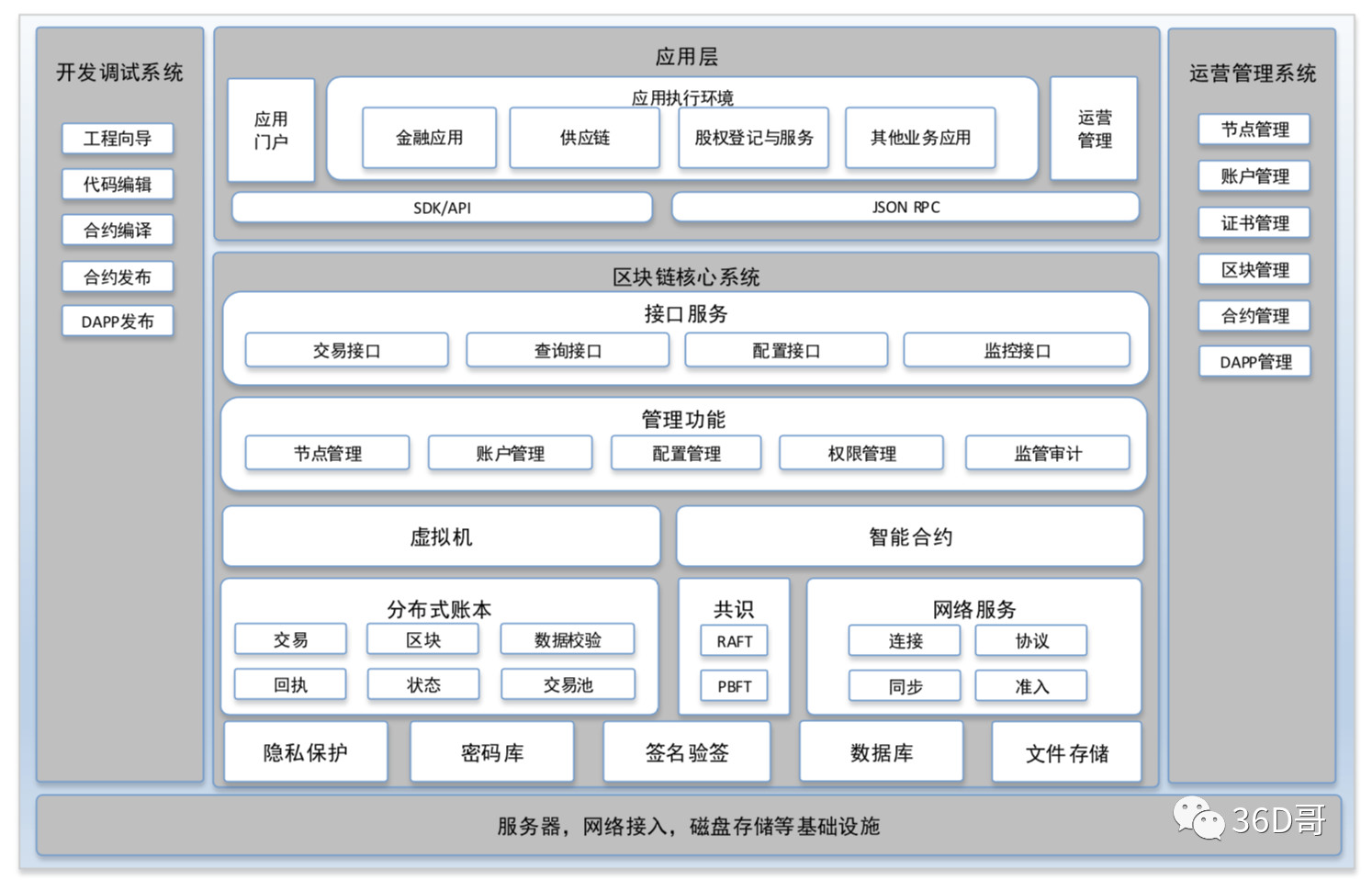
示意图 BCOS platform architecture diagram
The concept prototype of the BaaS platform first began in Amazon Web Services (Amazon Web Service), Amazon Web Services. Small and medium-sized enterprises have higher costs for Internet business. They need to purchase servers, network broadband, database services, and employ full-time network operation and maintenance personnel. Small and medium-sized enterprises generally cannot afford such high costs. Amazon centrally purchases servers, databases, network broadband, and deploys IDC nodes. Through computer virtual engineering technology (docker), the network services used to open a website can be customized and flexibly rented to enterprises, which greatly reduces the cost of establishing a website. The rapid development of Chinese companies on the same track as AWS in recent years also illustrates the tremendous commercial value of this technology. The domestic cloud service brands "Alibaba Cloud" and "Tencent Cloud" have annual revenues of more than 10 billion.
The blockchain BaaS platform is a fusion of various blockchain technologies, and leases various blockchain services used by enterprises to enterprises. Enterprises that want to launch blockchain services simply rent it from the platform and deploy it simply. All technology development platforms at the bottom of the blockchain have been completed. How much computing resources an enterprise needs, what architecture technology it uses, what kind of public recognition algorithm is used, how many public knowledge nodes are formed, how long does it take to generate blocks, and the block size just needs to be set by yourself. The blockchain Baas platform is an important service form that accelerates the landing of the blockchain in various industries, especially the deep integration with the real economy.

Going online-on the cloud-on the chain, at the same time as this series, it is also a down process. The down is the reduction of costs, and the down is the reduction of links. So far, the blockchain's architectural form has stabilized, but there is still a lot of uncertainty in the future, but there is an evolution law that is unchanged. All better organizational forms, structural forms, and technical services have fundamental driving forces for development Is to increase productivity. The public chain, the alliance chain, and the Baas platform will all end up in the same path, and jointly create a value Internet that is accessible to everyone and benefits everyone. Let blockchain technology push the entire society into the era of "trusted digitalization" and truly open a new chapter in the value Internet!
We will continue to update Blocking; if you have any questions or suggestions, please contact us!
Was this article helpful?
93 out of 132 found this helpful
Related articles
- People's Daily articles: digital currency, how much do you know
- On the Network Effect and Ecological Effect of Blockchain
- Professor of Tongji University: How Blockchain Keeps Being Innovative
- Perspectives | Digital currency opens a new global financial track
- Why is it important to mine a Filecoin header?
- God of V: Breaking the conventional thinking of the relationship between layer1 and layer2 of the blockchain
- Opinion: why oracles with economic guarantees are necessary components to create large-scale DeFi products





